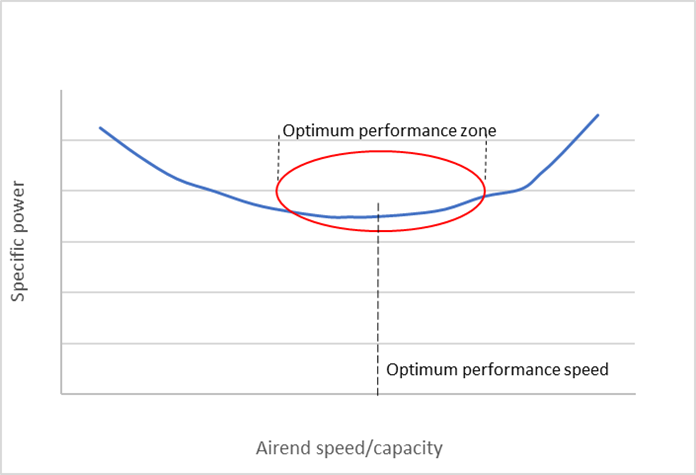
The most expensive component in the total cost of compressed air is energy. Over the lifespan of a typical compressor, energy often costs several times more than the purchase price of the compressor. According to the U.S. Department of Energy, electricity represents more than 75%¹ of the total costs of an air compressor over its lifecycle.
With this information top of mind, customers need the most efficient oil free rotary screw air compressor possible. You’ll hear a lot about turndown and how an exceptionally large turndown range is good for you. You may be told the compressor will adapt capacity to demand—true, yes, but it is rarely efficient. A large turndown range comes with costs and consequences on efficiency and total cost of ownership.
So, how can you see for yourself how efficient a variable speed drive (VSD) oil free rotary screw air compressor is? Check CAGI data sheets.
Sullair and most other major compressor manufacturers participate in CAGI’s performance verification program. This is a third-party testing program validating manufacturers’ claims of rotary screw compressor performance. CAGI then publishes data sheets, which each manufacturer makes available on its website.
When reviewing CAGI data sheets, closely review “specific power.” Specific power tells you how much power you must use for each certain cfm (kW/100 cfm). The higher the specific power, the more you should be concerned, because you will need more kW and pay more money to obtain the same amount of air. This is because you’re veering too far away from the optimum efficiency.

The above CAGI data sheet shows an example of a rotary screw compressor that operates at maximum efficiency. You’ll notice the line on the graph remains relatively flat. This means the compressor adapts to capacity of your demand efficiently. There are really no ebbs and flows on specific power, and therefore no fluctuating costs per cfm.
Next, compare this to the following graph. In the red circle, you see the capacity greatly fluctuates. You would pay up to 25% more in energy [kWh] to operate in this “zone.”

In the following graph, what is shown is optimum efficiency for VSD turndown.

Air ends are known as the heart of the air compressor. Each air end is designed with an ideal speed range – also known as optimum efficiency range – to deliver the highest efficiency and performance.
Rotary screw air ends are sensitive to variations in speed. If the air ends turn too fast or too slow, the efficiency can drop off significantly. By increasing or decreasing the rotation speed of the air ends, efficiency can either increase or decrease.

Sullair DSP VSD compressors are designed to operate in the red circle, or what is known as the optimum efficiency range. Inside this red zone, a VSD compressor runs at high efficiency and performance. Outside of this red zone, the VSD compressor runs at low capacity and is inefficient with poor performance. This also comes along with some risks, including:
In oil free rotary screw air compressors, high velocity is required for rotors to generate pressure and air flow in an efficient manner. Running a VSD compressor at a low speed becomes inefficient and, in extreme cases, can lead to air end failure, as mentioned above.
When evaluating which oil free rotary screw air compressor is right for you, pay close attention to turndown and how it can significantly impact your energy costs.
Customers buy VSD oil free rotary screw air compressors for two primary reasons. First, customers want to match compressor capacity to demand. Secondly, and most importantly, customers want to run more efficiently and save money on total cost of ownership and energy costs. Your compressor needs to meet both criteria. When your compressor stays in the optimum efficiency range, as illustrated in the graphic above in the red circle, you’re running efficiently, and the compressor is matching capacity to demand.
When operating outside of the optimum efficiency range (outside of red circle in graph above), capacity and demand are matched but it’s happening with very low efficiency and the cost per cfm increases—in some cases it nearly doubles. Then you’re actually increasing your total cost of ownership, as electricity represents a majority of the total costs of an air compressor over its lifecycle and cost of maintenance could increase too as air ends are more sensitive to suffering premature damages.
Whether you’re integrating a new compressor with existing equipment or a new system with multiple units, one of the most critical factors that will determine your success is how well the compressors work together. Ensure the capacity of your system is well-matched to the range of demand that will be experienced. Your local authorized Sullair distributor can conduct an AirSuite analysis to assess your system’s current performance and recommend the best solution.
¹ Determine the Cost of Compressed Air for Your Plant. Energy tips sheet, U.S. Department of Energy, December 2000
Use the checkboxes to select the types of cookies you want to accept, then press the “Save Settings” button. View our Privacy Policy.